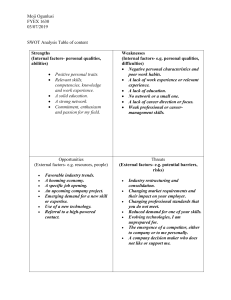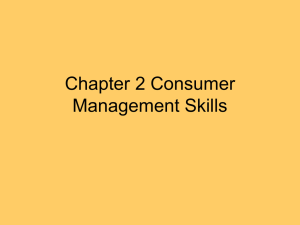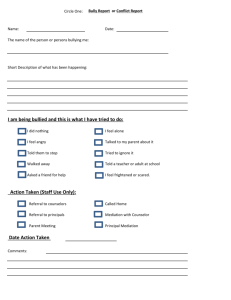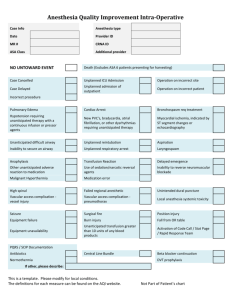Organizational change and Innovation
advertisement
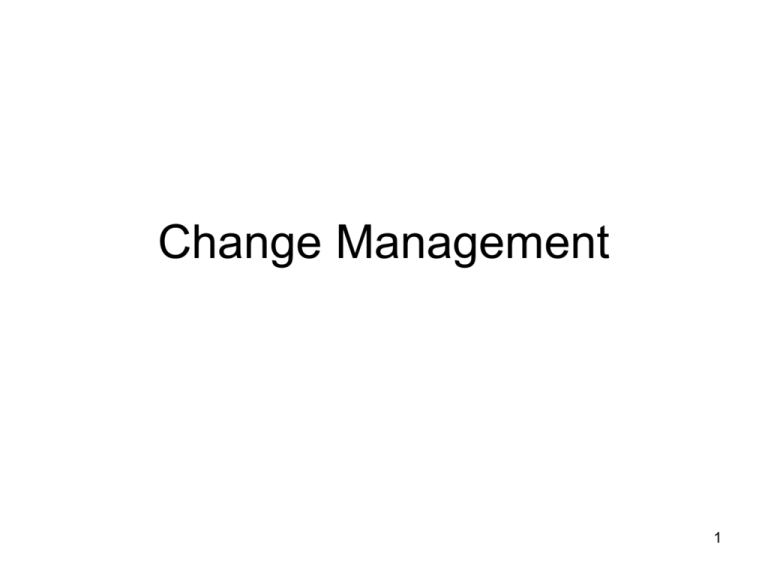
Change Management 1 From or To? • Changing from something – “We gotta get out of this place!” • Changing to something – “There’s a place for us…” • Doing both – Frankly, where are we now? – Where do we want to be? – What constitutes progress? When you say Change, they say: “This is a waste of time.” “Why change if it was working just fine before?” “If it ain't broke, don't fix it.” “They never tell us what’s going on!” “How soon will this happen?” “How will this impact me?” “Will I receive new training?” “What’s in it for me.” “I doubt they are really serious about this.” Natural reaction to change: Resist Awareness of need to change: critical ingredient and must come first Change in organizations Change usually starts with a high level task force that determines what changes need to be made. Change is always a factor in putting the puzzle together. Kinds of Change • Incremental – Tweaking the system or process • Transitional – Restructuring, reorganizing • Transformational – New vision, new mission, new values John Kotter • Mechanistic Change Vs Improvisational Change • Sequential VS Dynamic • Anticipated VS Unanticipated Mechanistic Change • Follows a series of sequential steps for envisioning, planning, implementing, consolidating, and institutionalizing their particular change component • Broken down into its component items, plotted out over the expected time it will take, and managed in pieces. • Considers only the anticipated change Planned vs. Unplanned Change Planned change – deliberate endeavor to impact an organization to make a difference; goal oriented • Routine • Expected • Maintenance of organization Planned vs. Unplanned Change Unplanned change – unexpected result of some large-scale force beyond local control • Reactionary • Unanticipated • Response to outside influence • Mechanistic Change Vs Improvisational Change • Two types of unanticipated change: • Emergent change: They arise spontaneously in response to planned change. Their impacts can be either positive or negative for an organization. For example, the introduction of a new technology can eventually lead to the need for new roles and skills and may also affect organization structures and management processes. To changes they can predict, managers should also be prepared to deal with two types of unanticipated change: • Emergent change: They arise spontaneously in response to planned change. Their impacts can be either positive or negative for an organization. • Opportunity-based change: These are introduced intentionally during the change process in response to unexpected impacts that arise. Change is a dynamic entity This figure illustrates how change is actually a dynamic process consisting of a series of planned changes, interspersed with controlled organizational responses to emergent and opportunity-based changes as they arise. Do organizations have to change? Turbulent Times The Changing Work Place • Today’s organizations need to continuously adapt to new situations if they are to survive and prosper One of the most dramatic elements is the shift to a technology- driven workplace Ideas, information, and relationships are becoming critically important 13 From where the pressure on organization come? Organizations have to change because they are subject to pressures from the outside world, the sector, their local area, and from within Inside the organization Closer to home The outside the world 14 Outside the world • Political factors- government policies and initiatives, attitudes to industry and competition, political alignments at home and abroad. • Economic factors- interest rates, currency exchange rates, consumer expenditure, inflation • Social and cultural factors- where people live, education and health, social mobility, social and cultural attitudes to work, home and community life and behavior • Technological factors- new product and services, access and availability of new technologies becoming outdated • Legislative factors- employment law, taxation law, health and safety legislation • Environmental factors- pollution control, water, transport and development policies, waste disposal • -------or any combination of these. 15 Closer to home • The pool of potential customers- do they want the organization’s product and services? Can they get them cheaper or more easily elsewhere? • Competitors-what action is the competition taking to steal the organization’s customers • Suppliers-does the organization have a choice of suppliers and are they keen to get the organization’s business? • Labour Market- are there enough workers with the right skills? • Local conditions- what’s happening locally that affects the organization viability? 16 Within the organization itself • A new boss might have different styles and approach or want to take the organization in a new direction • A new strategy may be stimulated by an analysis of external forces and may involve: providing new products and services, cutting costs, moving into new market… • Attempts to make the organization more efficent by changing the way people work. 17 What is organizational change? Any substantive modification to some part of the organization. 18 Steps in organizational change? (or) How to Change? Phases of planned change.- Kurt Lewin Model (1947) – Unfreezing. • Preparing a situation for change by disconfirming existing attitudes and behaviors. • Getting ready to change, change is necessary – Changing(Transition) • A PROCESS • Taking action to modify a situation by altering the targets of change. • The MOST hardest – Refreezing. • Reinforcing, Maintaining and eventually institutionalizing the change. 19 What can be done about resistance to change? Ways in which resistance is experienced. – Resistance to the change itself. – Resistance to the change strategy. – Resistance to the change agent. 20 Transformation Process Phase Content Outcomes Unfreeze Set the direction Create the desire & will to change Break with the past Mobilise Make early changes & build confidence Build the energy Realise Secure widespread shift in behaviour Perfor m-ance lift-off Reinforce Underpin with changes in structure & people processes Embed new culture Part Sustain Strive for continuous performance improvement Push the limits Types of change Top down Development Programme Restructuring Strategy Takeover, merger Radical Gradual Problem solving Actively seek New job Learning Continuous improvement Bottom up 22 Radical change • It is characterized by a major shift in the way people work or act, perhaps requiring different values and attitudes. • A radical change is often marked by a decision to make a distinct break from a current situation in order to reach a desired future situation. Also known as frame-breaking change. • Change that results in a major overhaul of the organization or its component systems. Breakpoint decisions Current situation Process of change Desired future situation 23 Some radical change is open-ended-a change is followed by soon by another and perhaps more to come, Breakpoint decisions Plan change Current situation Desired future situation Review/evaluate Implement Change processes 24 Gradual/Incremental change. Also known as frame-bending change. Change that is part of the organization’s natural evolution. Top-down and bottom-up change • Top-down change is imposed by others, usually those who in powers. • Bottom-up change is planned and let by the people who carry it out. It is often gradual, involving small incremental changes 25 Model of Change Sequence of Events Environmental Forces Monitor global competition, and other factors Internal Forces Consider plans, goals, company problems, and needs Need for change Initiate change Implement change Evaluate problems and opportunities, define needed changes in technology products, structure, and culture Facilitate search, creativity, idea champions, venture teams, skunk works and idea incubators Use force field analysis, tactics for overcoming resistance 26 Forces for Change • Environmental Forces – Customers – Competitors – Technology – Economic – International arena • Internal Forces – activities and decisions 27 Need for Change Performance gap = disparity between existing and desired performance levels. How do we know this?? Current procedures are not up to standard ● New idea or technology could improve current performance 28 Initiating Change Critical phase of change management • Stage where the ideas that solve perceived needs are developed • Search = process of learning about current developments inside or outside the organization that can be used to meet the perceived need for change • Creativity = generation of novel ideas that might meet perceived needs or offer opportunities for the organization Experiential Exercise: Is Your Company Creative? 29 Why Use IT to Change? Using new IT allows companies to gain important advantages such as: 1) cost savings and improving the accuracy of exchanging information; 2) avoiding human mistakes inherent when complex and repetitive tasks are used; 3) saving money because it reduces errors and the time it takes to accomplish tasks; 4) integrating and coordinating several functions at once; and 5) improving the organizational efficiency and effectiveness by eliminating delay, administrative intermediaries, and redundant processing steps and by providing better access to information. How IT Assist Change • IT is frequently the means through which change is implemented in a company. • In general, IT facilitate change through: 1.increasing information flow 2.technological discontinuity 3. new business practices 4. increasing customer expectations • Processes may be classified according to two dimensions: 1.degree of mediation and 2. degree of collaboration Degree of mediation • Refers to the sequential flow of input and output among the participants' functions in a business process. • A process at a high degree of mediation involves a large number of intermediate steps, performed in various functions that contribute indirectly to the process outcome. • A process at a low degree of mediation has several functions that contribute directly to the process outcome without the mediation of sequential steps. Degree of collaboration • Is related to the degree of collaboration between functions through information exchange. • The frequency and intensity of information exchange can range from: – none (process at the low degree of collaboration) to – extensive (process at the high degree of collaboration). •SO HOW IT HELPS? Companies must reduce the degree of mediation in processes. >>Convert processes with a great number of intermediate steps into processes that take part directly in the final outcome. The ITs that make this modification easy might be: 1) Shared databases: Different functions are allowed to take part directly by using the information stored in databases. Each function can approach, enter, or recover information from this database the moment it is needed. 2) Imaging technology: Several people may work at the same time on a digitalized image of documents or graphics. 3) Electronic data exchange and electronic funds transference. • Companies must increase the degree of collaboration in processes so that involved functions will share information. • The IT that makes the collaboration easy among different people may be communication technologies. • These allow information transfer by using tools such as electronic mail, video conference, and file transfer protocol. Food for thought… • All progress requires change. But not all change is progress. John Wooden • Continuity gives us roots; change gives us branches, letting us stretch and grow and reach new heights. Pauline Kezer • Things do not change; we change. Henry David Thoreau • That is because Allah has never changed the blessings which He has bestowed on a people until they themselves changed the condition of their souls; verily Allah hears all and knows all.(Al-Anfal:53) • Lo! Allah change not the condition of a folk until they (first) change that which is in their hearts; and if Allah will not misfortune for a folk there is none that can repel it, nor have they a defender beside Him. (Ar-R’ad:11) Chapter 1 © 2008 by Prentice Hall 39
